
Top 10 Mega Infrastructure Projects Under Construction in UK (2025)
Table of Contents
The United Kingdom is in the midst of a once-in-a-generation infrastructure transformation, driven by an ambitious GBP 725 billion investment, set to reshape the nation by 2035.
This progress is guided by the UK government's 10-Year Infrastructure Strategy, and 2025 marks an important year as record levels of capital investment fuel the delivery of major projects across transport, energy, water, digital connectivity, and public services.
Some of the largest upcoming infrastructure projects in the UK include High Speed 2 (HS2), Sizewell C Nuclear Power Station, Hinkley Point C Nuclear Power Station, Palace of Westminster Restoration, and Lower Thames Crossing. These large construction projects are based on long-term resilience, economic growth, and net-zero targets.
This article highlights the Top 10 major infrastructure projects in UK in 2025.
List of Top 10 Upcoming Infrastructure Projects Under Construction in UK (2025)
Project Name | Location | Estimated Project Cost | Start Date | Expected Completion Date |
High Speed 2 (HS2) | Primarily connecting London and Birmingham | GBP 80+ billion | 2017 | Phase One: Early 2030s; Future phases: Late 2030s onwards |
Sizewell C Nuclear Power Station | Sizewell, Suffolk, England. | Up to GBP 40 billion (initial phases GBP 14.2 billion committed) | Main construction TBD (FID Summer 2025) | Early 2030s |
Hinkley Point C Nuclear Power Station | Bridgwater, Somerset, England. | GBP 31 - GBP 35 billion | 2016 | Unit 1: 2029; Unit 2: Shortly after. |
Palace of Westminster Restoration | London | GBP 13 billion | 2024 | 2035 (est.) |
Lower Thames Crossing | Connecting Kent and Essex, east of London. | GBP 10 billion | Late 2025 (Enabling works) | 2032 |
Brent Cross Town | Brent Cross, London | GBP 8 billion | 2016 | First phase 2025, full 2030 |
East West Rail | Oxford–Cambridge | GBP 5–8 billion | 2022 | 2030 (phased) |
Eastern Greenlink 2 | Aberdeenshire to North Yorkshire | GBP 5 billion | 2024 | 2029 |
London Gatwick Airport Northern Runway | West Sussex | GBP 2.2 billion | 2025 | 2029 |
London Gateway Port Building Extensions | Essex, East England | GBP 1 billion | 2024 | 2027 |
High Speed 2 (HS2) – The UK’s Largest High-Speed Rail Project
.webp)
High Speed 2 (HS2) is the biggest upcoming infrastructure project in the UK. The project, launched in 2019, is designed to be Britain’s second purpose-built high-speed railway after High Speed 1, which links London to the Channel Tunnel.
It was originally planned as a comprehensive north-south rail network connecting London with Birmingham, Manchester, East Midlands Parkway, Leeds, and York. In October 2023, then Prime Minister Rishi Sunak announced that only Phase 1 would proceed, scrapping later phases in the north due to budget and planning concerns.
Key points about High Speed 2 (HS2):
Over 75% of tunnelling is complete
Work has begun on two-thirds of the viaducts and more than half of the bridges
The project includes 32 miles of tunnels, along with extensive embankments, cuttings, bridges, and viaducts
Over 31,000 jobs are currently supported by HS2
New stations at Curzon Street (Birmingham), Interchange (Solihull), Old Oak Common, and Euston (London) will serve as modern transport hubs
Recent Update: First Platforms Installed at Old Oak Common Station in July, as engineers began installing the first platforms at Old Oak Common Station in west London.
Sizewell C Nuclear Power Station
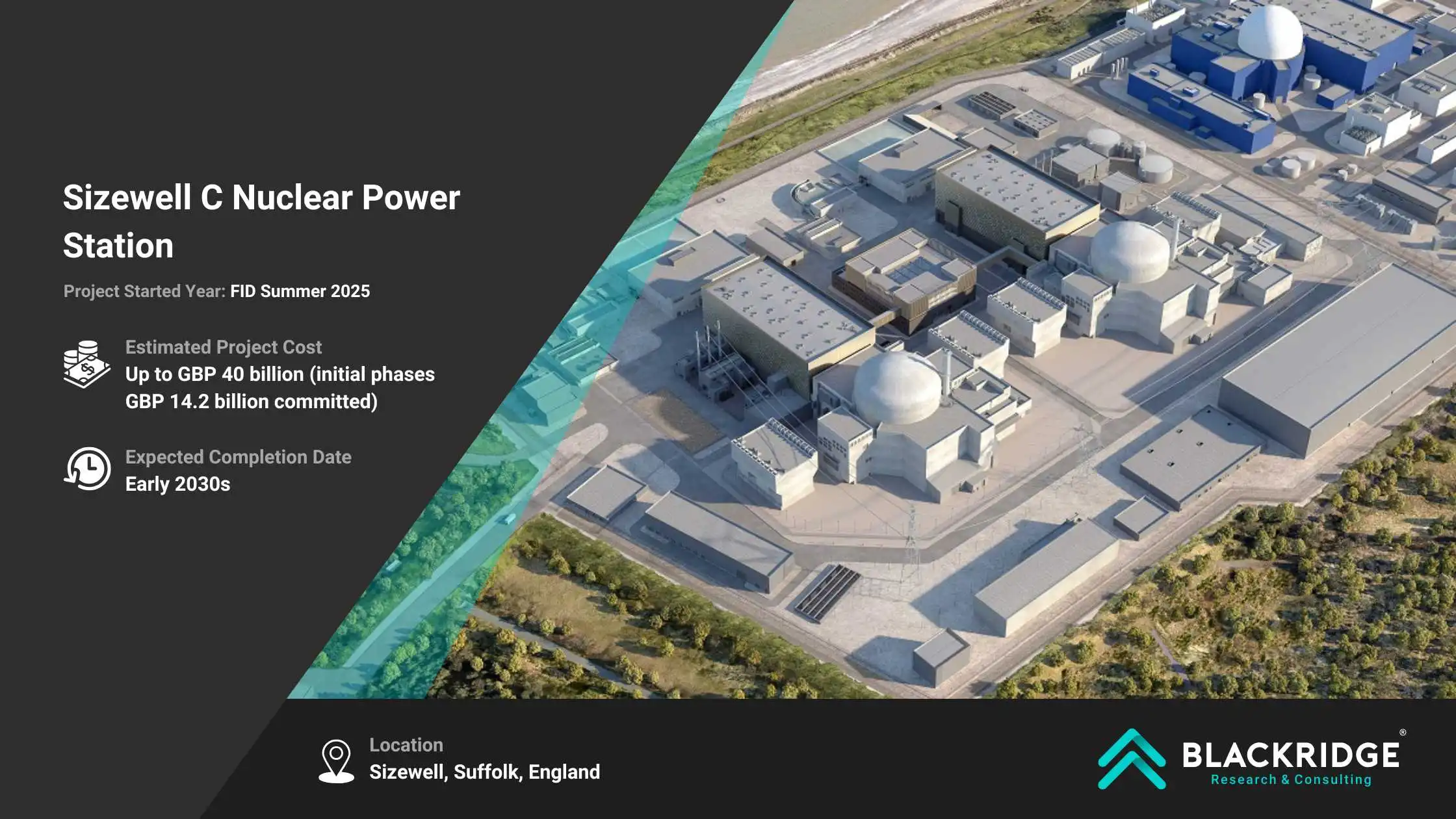
Sizewell C is one of the UK’s most critical upcoming infrastructure projects, aiming to secure the country’s long-term energy needs through low-carbon nuclear power. The project is located on the Suffolk coast beside the existing Sizewell A and B plants.
It is the UK’s only majority state-owned nuclear power station, with the Secretary of State for Energy Security and Net Zero owning 75% or more of the shares, and EDF Energy holding the remaining minority stake.
The government formally approved the project in June 2025, allocating GBP 14.2 billion toward its construction, with additional funding sourced through private investment and consumer financing under the Regulated Asset Base (RAB) model.
Key points about Sizewell C:
Sizewell C will generate 3.2 GW of baseload, low-carbon electricity – about 8% of the UK’s annual electricity consumption
The plant is expected to operate at a 90% capacity factor, offering highly reliable energy output year-round
Pre-construction work is underway as of June 2025, with full construction expected to take 9 to 12 years, targeting completion by the mid-2030s
Recent Update: In July 2025, French energy company EDF announced an investment of GBP 1.1 billion in the Sizewell C nuclear plant and will take a 12.5% stake in the nuclear project.
Hinkley Point C Nuclear Power Station

Hinkley Point C (HPC) is one of the biggest energy infrastructure projects in Europe and a cornerstone of the UK’s clean energy strategy. Located in Somerset, England, HPC is a two-unit, 3.2 GW European Pressurised Reactor (EPR) nuclear power station. Once operational, it will provide enough electricity to power six million homes and supply around 7% of the UK’s total electricity demand.
Hinkley Point C is currently Europe’s largest construction site. The nuclear power plant offers a low-carbon energy mix, offering reliable, baseload electricity while avoiding millions of tonnes of CO₂ emissions annually.
Approved by the UK Government in September 2016 following EDF board approval in July 2016, the plant is financed by EDF Energy in partnership with China General Nuclear Power Group (CGN). It was among eight potential nuclear sites identified by the British government back in 2010.
Key points about Hinkley Point C:
Hinkley Point C will deliver 3.2 GW of low-carbon electricity, equivalent to powering 6 million homes.
It will contribute 7% of the UK’s electricity supply.
The project is generating a GBP 13 billion boost for the UK economy.
Recent Update: Apollo Global Management (APO) is reportedly close to finalizing a financing deal with EDF to provide up to GBP 5 billion in debt financing for the Hinkley Point C nuclear power station.
Palace of Westminster Restoration

The Palace of Westminster Restoration is one of the UK’s most complex and high-profile construction projects, aiming to preserve the structural and historical integrity of one of the nation’s most iconic landmarks.
This vast engineering programme follows over 7,500 hours of detailed surveys, which identified critical risks and deterioration across the Grade I-listed structure.
Key points about the Palace of Westminster Restoration:
A total projected cost of GBP 13 billion, making it one of the largest projects in UK construction industry.
GBP 750 million has already been allocated for urgent stabilisation and safety work.
Recent update: Simon Thurley, a distinguished architectural historian, heritage expert, and leader of major heritage restoration programmes, has been appointed as Chair of the Restoration and Renewal Delivery Authority.
40+ reviews
Find the Latest Infrastructure Projects in Europe
Gain exclusive access to our industry-leading database of infrastructure project opportunities with detailed project timelines and stakeholder information.
Collect Your Free Leads Here!
No credit cardUp-to-date coverage
Joined by 750+ industry professionals last month
Lower Thames Crossing - The UK’s Longest Road Tunnel Project
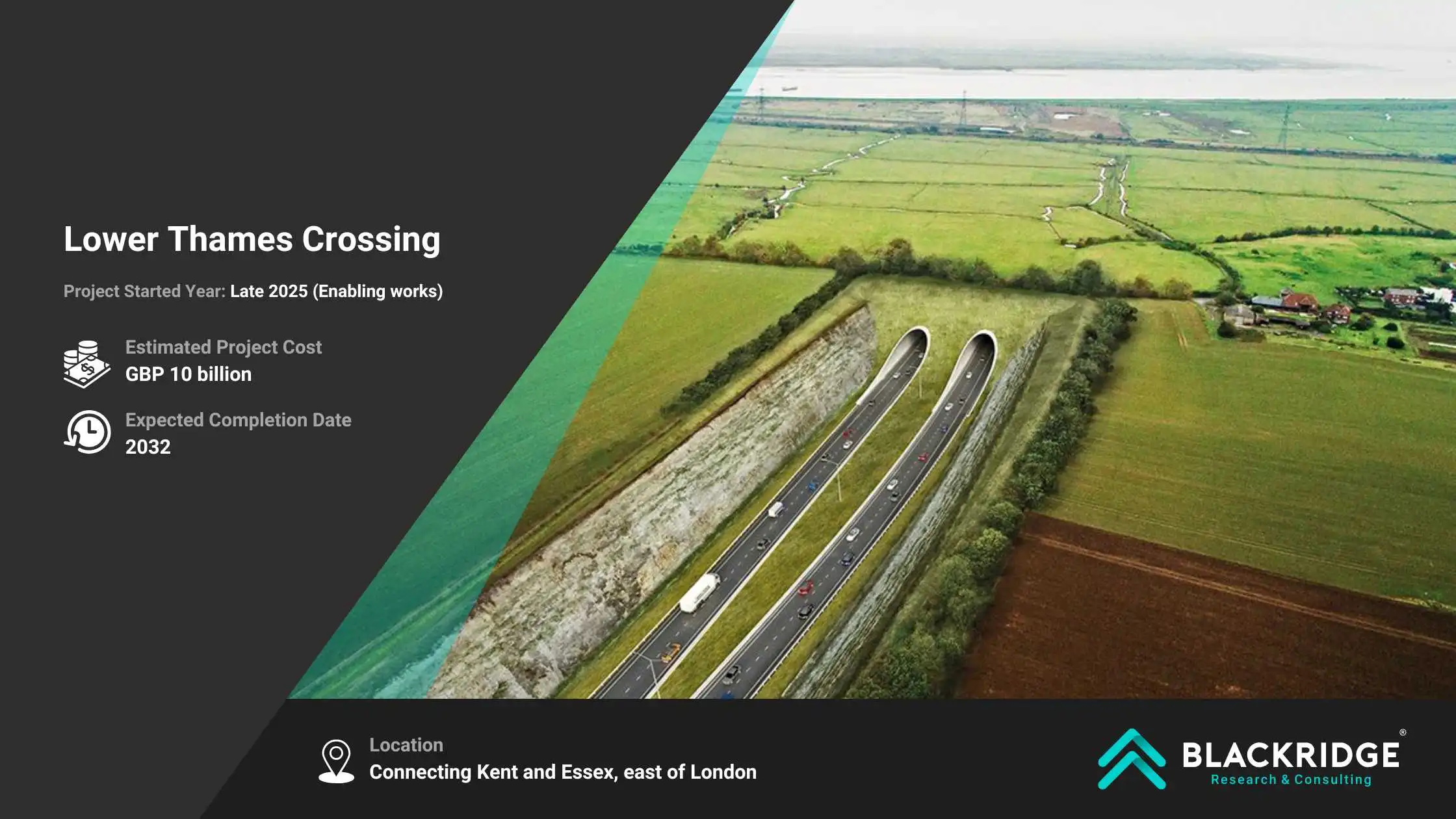
The Lower Thames Crossing is one of the longest road infrastructure projects currently underway in the UK developed by National Highways England. The project is designed to significantly relieve congestion at the heavily used Dartford Crossing. This new route will provide a 14.3-mile road link between Kent and Essex, featuring the UK’s longest road tunnel beneath the River Thames.
At the heart of the project is a 2.6-mile twin-bore tunnel, located east of the village of Chalk in Kent and west of East Tilbury in Essex. Once completed, the Lower Thames Crossing will almost double road capacity over the Thames east of London.
Key points about the Lower Thames Crossing:
Designed to make journeys more reliable, faster, and safer, particularly for freight and long-distance traffic.
Connects key routes: A2/M2 in Kent to A13 and M25 in Essex.
Expected to drive economic growth across the Thames Estuary and southeast England.
Recent update: In June, the UK government granted GBP 590 million as part of a GBP 1 billion package, announced to improve transport infrastructure across England.
Brent Cross Town - London’s GBP 8 Billion Park Town Regeneration
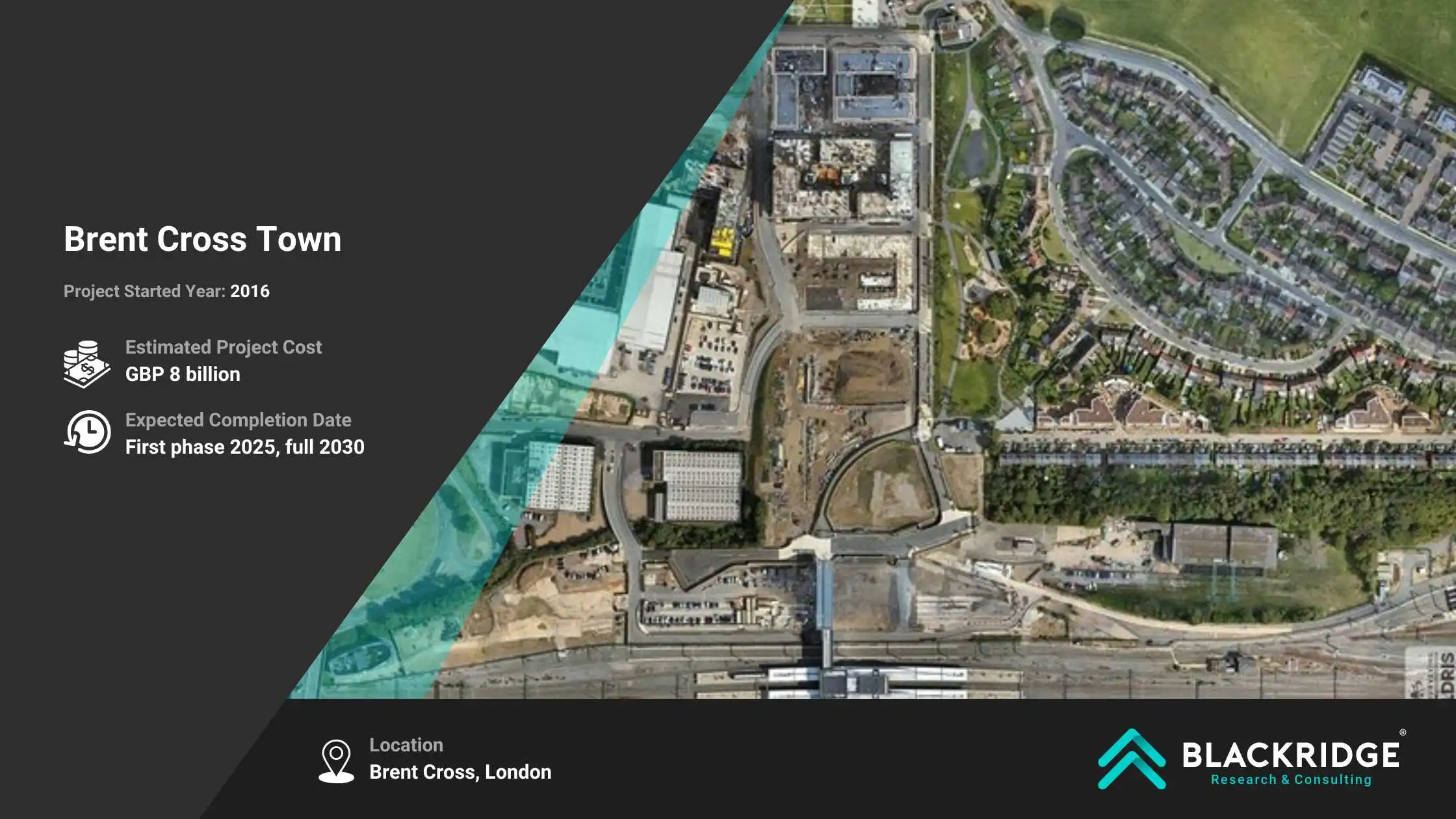
Brent Cross Town is a transformative GBP 8 billion regeneration project that forms a key part of the Brent Cross Cricklewood masterplan (one of the largest urban renewal schemes in Europe).
The mixed-use development project spans over 180 acres (72.8 hectares) in the London Borough of Barnet and aims to establish a new, sustainable "park town" that integrates residential, commercial, educational, and green infrastructure.
Construction began in 2020 and was jointly developed by Barnet Council and Related Argent under the Brent Cross South Limited Partnership (BXS LP). The town is designed with a clear focus on health, sustainability, and community wellbeing.
Key Points about Brent Cross Town:
Homes: 6,700 new residences, including Build-to-Rent, student housing, and a retirement village
Office Space: 3 million ft², supporting 25,000 jobs
Education: Home to Sheffield Hallam University's first campus outside Yorkshire
Green Spaces: 50 acres of parks, including Claremont Park and Exploratory Park
Transport Links: Served by Brent Cross West station (new) and Brent Cross Underground (Northern Line)
Recent update: Fusion Students is set to launch an inspiring new development in the heart of Brent Cross Town. The project is set to open its doors on 6 September 2025.
East West Rail - Reconnecting Oxford and Cambridge
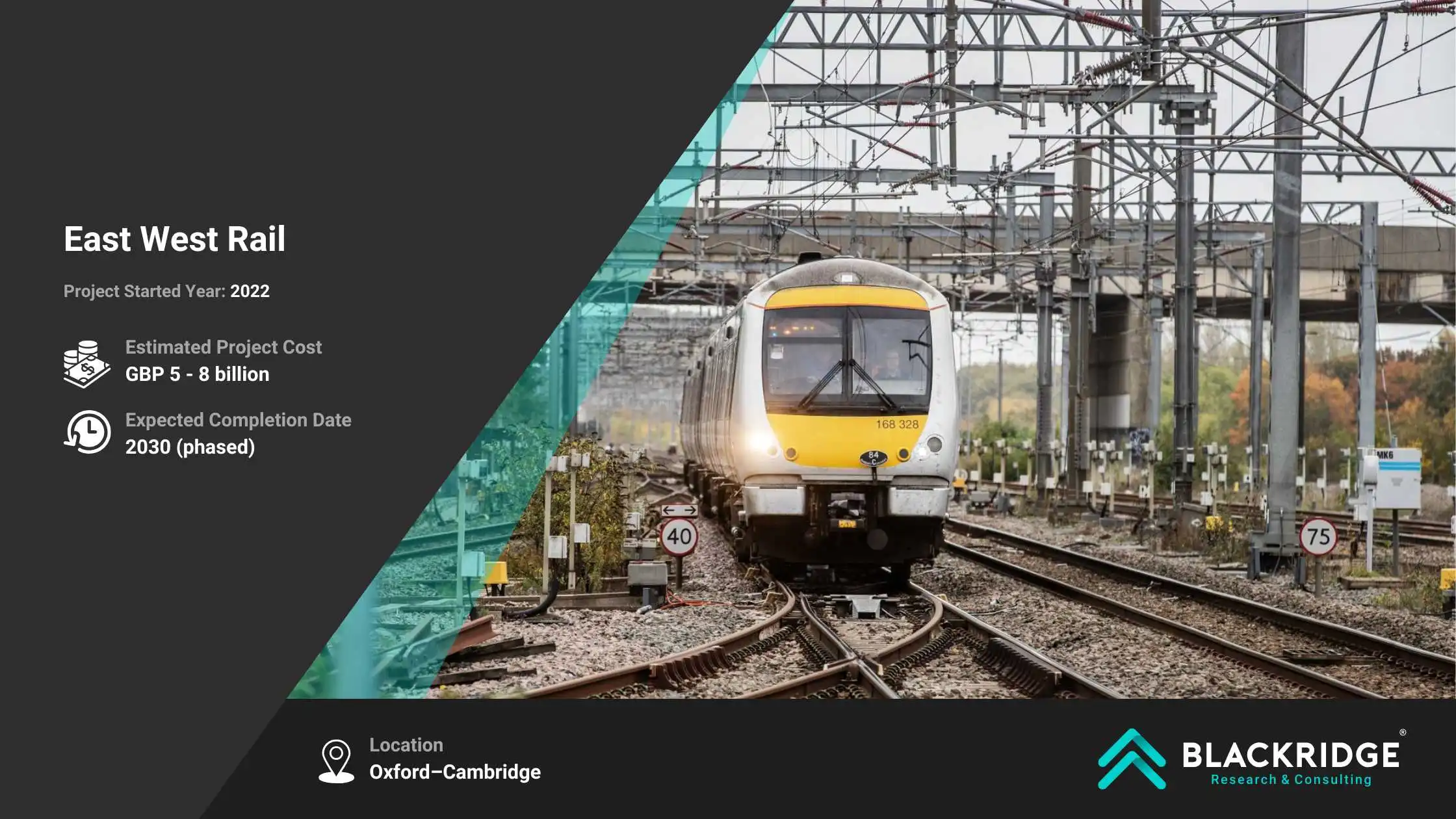
East West Rail (EWR) is a transformative railway infrastructure project aiming to re-establish a direct rail connection between East Anglia and Oxfordshire, with a core focus on the Oxford–Cambridge corridor.
The network rail project will deliver a new main line (also referred to as the East West Main Line) that links Oxford, Bicester, Milton Keynes, Bedford, and ultimately Cambridge, by restoring much of the historic Varsity Line.
This strategically important high speed rail line will improve east–west connectivity across southern England. The entire route spans over 95 miles, combining newly built and upgraded existing track infrastructure.
Project Delivery: Three Connection Stages
Connection Stage 1 (CS1):
Oxford → Bicester → Bletchley → Milton Keynes
Connection Stage 2 (CS2):
Oxford → Bedford
Connection Stage 3 (CS3):
Oxford → Cambridge (via Bedford and new alignments toward Cambourne and Cambridge)
Recent Update: In June 2025, the East West Rail line launched its first freight service, supporting a new strategic rail freight interchange in Northampton.
Eastern Green Link 2 (EGL2)

Eastern Green Link 2 (EGL2) is a major UK infrastructure project that will create the longest high-voltage direct current (HVDC) electricity transmission connection across the country. The 2 GW HVDC “superhighway” will run from Peterhead in Aberdeenshire, Scotland, to Drax in North Yorkshire, England, predominantly via a 436 km subsea underground cable through the North Sea.
An additional 69 km of underground onshore cable will be installed in England, connecting the landfall point at Fraisthorpe Sands to a new converter station at Drax. The project is jointly delivered by Scottish and Southern Electricity Networks Transmission (SSENT) and National Grid Electricity Transmission (NGET) showcasing the potential of collaborative efforts, technology's transformative power, and sustainable practices.
The project also incorporates sustainability measures, such as using Hydrogenated Vegetable Oil (HVO) fuel for construction equipment in Yorkshire, to reduce carbon emissions during the build phase.
Key Points about Eastern Green Link 2:
Route: From Peterhead, Scotland, to Drax, England; 436 km subsea + 69 km onshore cable
Technology: 525 kV HVDC Light® converter stations by Hitachi Energy
Capacity: 2 GW – enough to power around two million UK homes
Timeline: Construction starts in 2024, completion expected in 2029
Recent update: The Swedish Export Credit Corporation (SEK) has agreed a EUR 800 million loan facility with National Grid Electricity Transmission plc to fund a portion of Eastern Green Link.
London Gateway Port Building Extensions
.webp)
The London Gateway port, operated by DP World, is undergoing a major GBP 1 billion expansion aimed at transforming it into the UK’s largest container port. This key infrastructure development will add two new 400-metre all-electric shipping berths and a second rail terminal.
Once completed, the expanded port will have the capacity to simultaneously handle six of the world’s largest container ships. The expansion is a strategic move to increase the UK’s trading capacity and improve logistics efficiency. Construction began in May 2025 and is expected to take four years.
The development also supports the Thames Freeport initiative and is expected to create 400 permanent jobs. Europe’s tallest quay crane will be installed as part of the project to accommodate the larger vessels. DP World’s investment was first announced at the UK Government’s International Investment Summit in October 2024.
Key Points about London Gateway port building extensions:
GBP 1 billion expansion by DP World
Adds two 400m berths and a second rail terminal
Europe’s tallest quay crane is included
400 new permanent jobs to be created
Construction began in May 2025, and completion is expected in 2029
Recent Update: Construction on DP World’s GBP 1 billion expansion of London Gateway port began in May 2025.
London Gatwick Airport Northern Runway
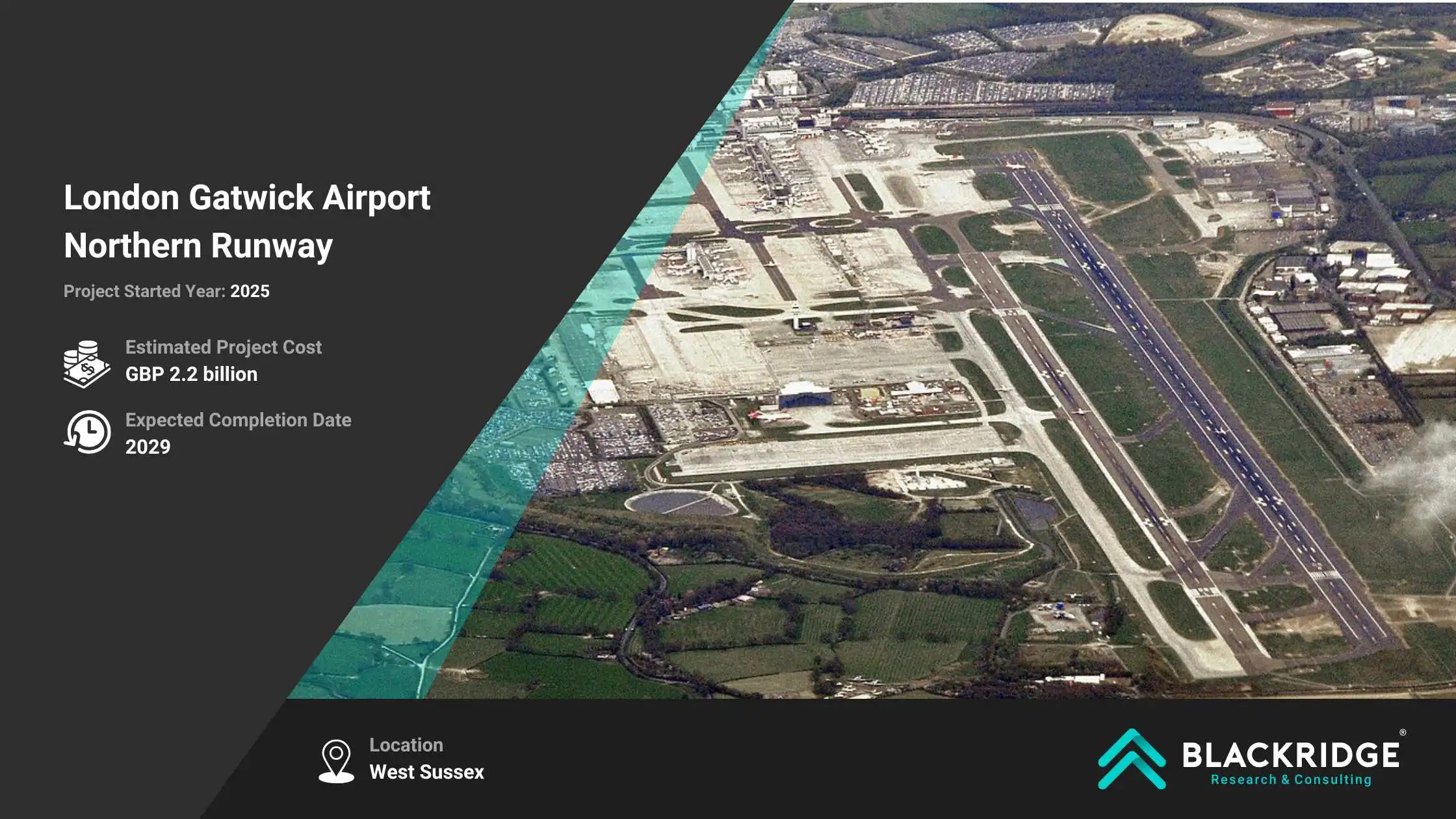
The London Gatwick Airport Northern Runway Project (NRP) aims to convert the existing standby northern runway into a fully operational second runway. This enables the dual runway operations alongside the main runway.
To achieve this, the northern runway would be repositioned 12 meters north, with extensive upgrades to taxiways, terminals, aircraft stands, and support facilities. The project is classified as a Nationally Significant Infrastructure Project (NSIP) due to the expected increase in passenger throughput by over 10 million per year.
In addition to the runway realignment, the development will include terminal expansions, a new pier, waste and maintenance facilities, new office space, hotel rooms, and road improvements, all largely contained within the current airport boundary.
Gatwick Airport Limited submitted the application in line with NSIP regulations, and the project is currently in the decision stage. A final decision from the Secretary of State is expected by 27 October 2025.
Key Points London Gatwick Airport Northern Runway:
Increase in capacity to handle up to 80.2 million passengers annually by 2047
Includes upgrades to terminals, taxiways, aircraft stands, roads, and support facilities
18,500 new parking spaces and additional office/hotel development
Designated a Nationally Significant Infrastructure Project (NSIP)
Recent Update: The construction project is currently in the decision stage, with a final decision expected by 27 October 2025.
Wrapping Up
The year 2025 marks a defining moment in the UK’s infrastructure evolution, with UK government's public sector infrastructure schemes and private infrastructure investment driving forward some of the most ambitious construction projects in the country’s history. From high-speed rail and nuclear power to digital infrastructure and port expansions, these top 10 mega projects illustrate the scale, diversity, and strategic intent behind the UK’s long-term development goals.
Another milestone in Infrastructure projects in London is the new GBP 5 billion Thames Tideway Tunnel made to revamp the city's Victorian sewage system has been fully connected after 10 years of construction work.
As these UK construction projects move through planning, development, and construction phases, they will deliver thousands of jobs, economic growth, support sustainable growth, stimulate innovation, and reinforce the construction industry in UK as a global leader.
Find All the Upcoming Infrastructure Development Projects in European Union (EU)
Are you searching for a trusted platform that delivers accurate, timely, and in-depth insights into upcoming infrastructure development projects in EU?
Explore the Global Project Tracking (GPT) platform by Blackridge Research, your one-stop source for discovering the latest infrastructure development projects in EU at every stage of development:
Upcoming Projects
Tender Notices
Contract Awards
Projects Under Construction
Completed Facilities
Book a free demo today to stay ahead with real-time project intelligence and make informed business decisions faster
Leave a Comment
We love hearing from our readers and value your feedback. If you have any questions or comments about our content, feel free to leave a comment below.
We read every comment and do our best to respond to them all.